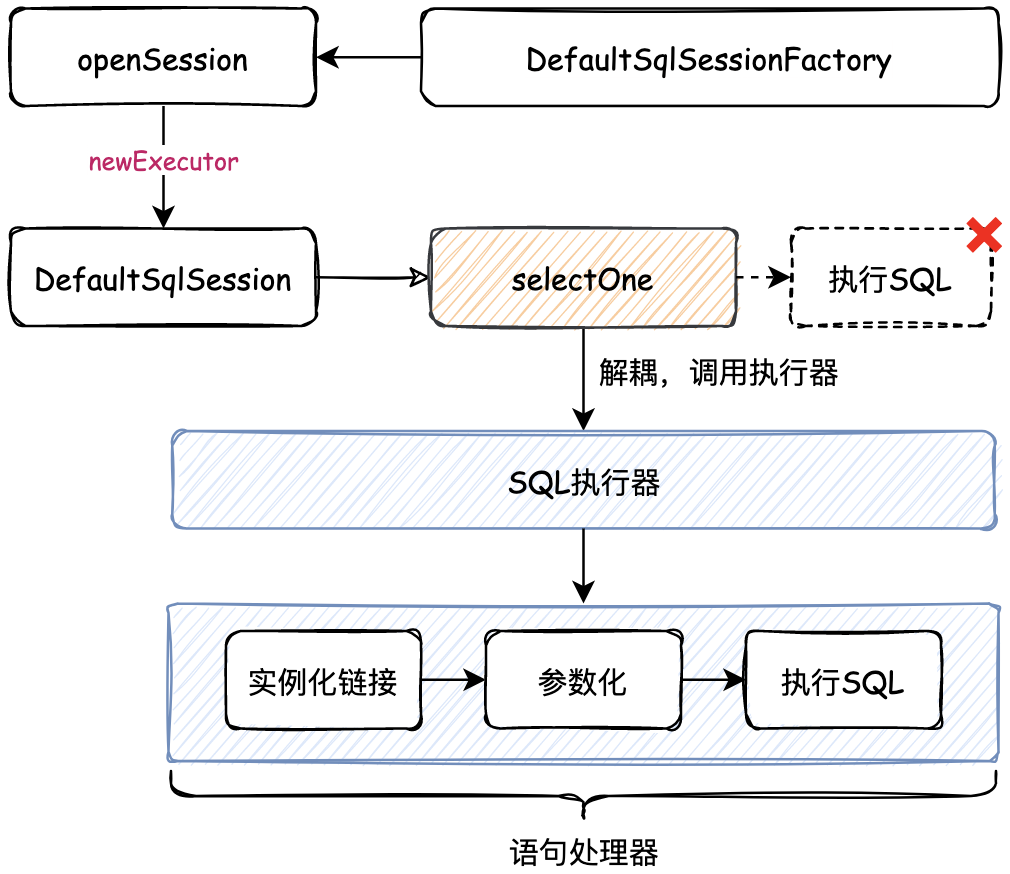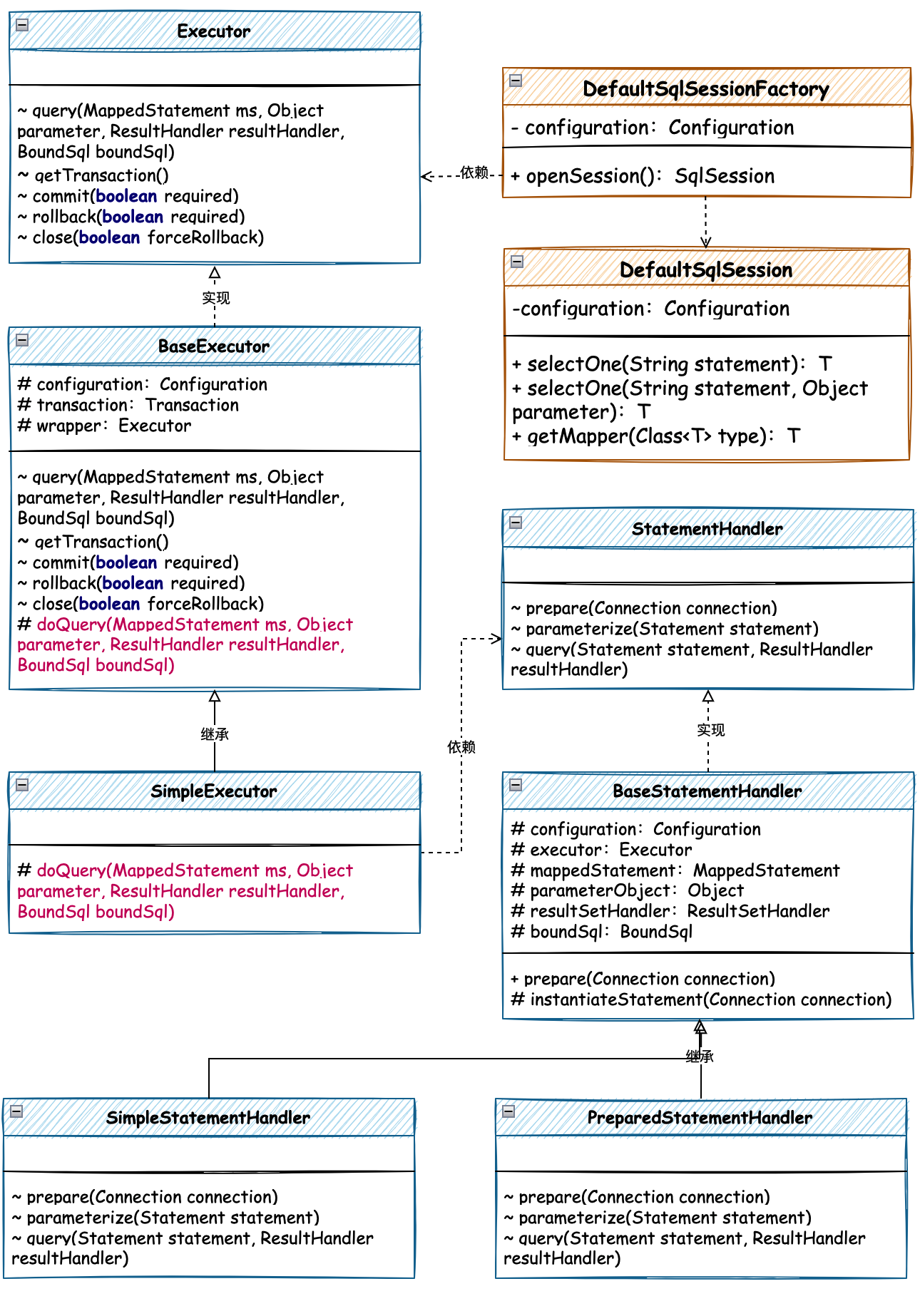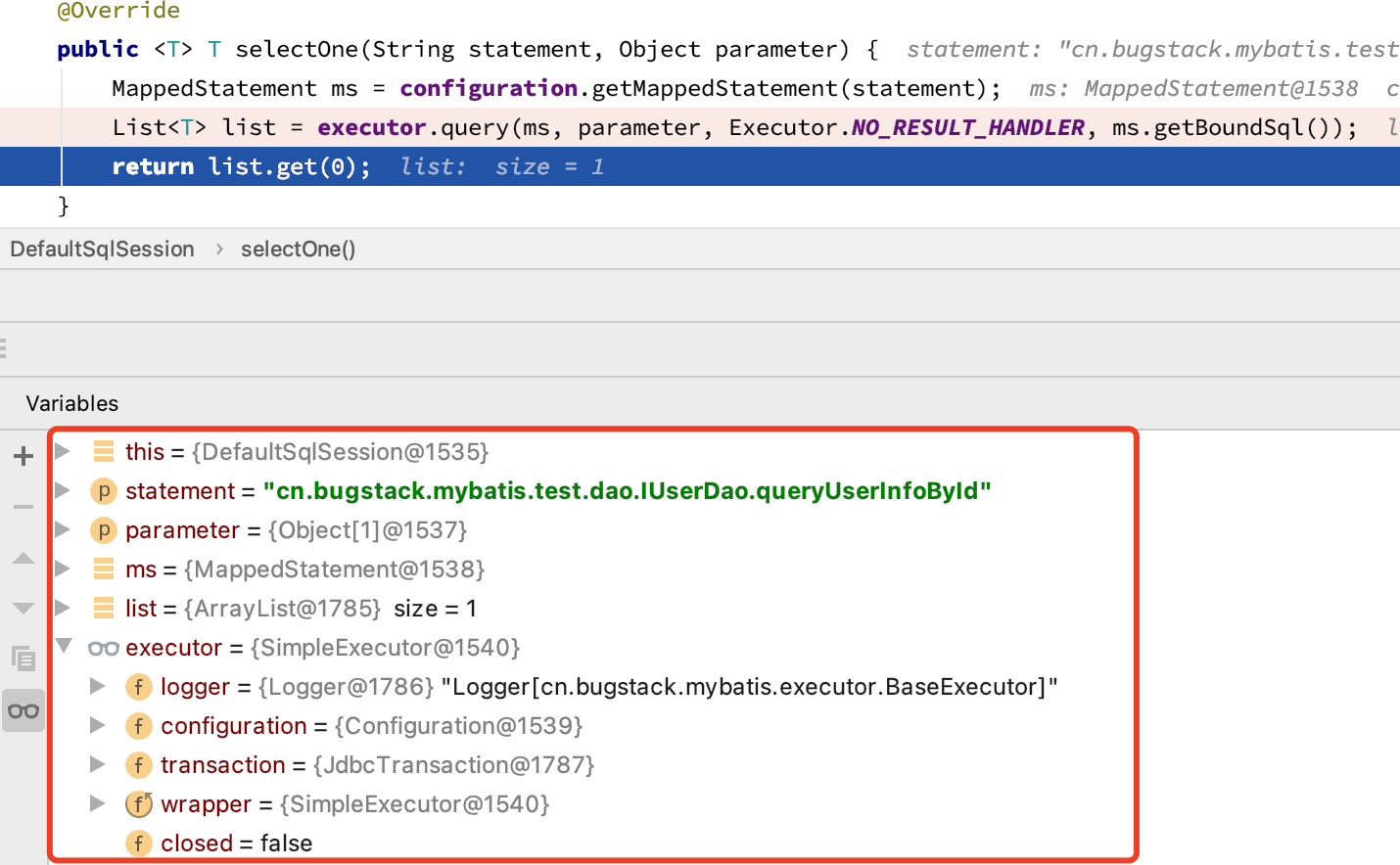# 《Mybatis 手撸专栏》第7章:SQL执行器的定义和实现
作者:小傅哥
博客:https://bugstack.cn (opens new window)
原文:https://mp.weixin.qq.com/s/MJYKOn0-jhnGurcbDxgWtA (opens new window)
沉淀、分享、成长,让自己和他人都能有所收获!😄
# 一、前言
为什么,要读框架源码?
因为手里的业务工程代码太拉胯了!通常作为业务研发,所开发出来的代码,大部分都是一连串的流程化处理,缺少功能逻辑的解耦,有着迭代频繁但可迭代性差的特点。所以这样的代码通常只能学习业务逻辑,却很难吸收到大型系统设计和功能逻辑实现的成功经验,往往都是失败的教训。
而所有系统的设计和实现,核心都在于如何解耦,如果解耦不清晰最后直接导致的就是再继续迭代功能时,会让整个系统的实现越来越臃肿,稳定性越来越差。而关于解耦的实践在各类框架的源码中都有非常不错的设计实现,所以阅读这部分源码,就是在吸收成功的经验。把解耦的思想逐步运用到实际的业务开发中,才会让我们写出更加优秀的代码结构。
# 二、目标
在上一章节我们实现了有/无连接池的数据源,可以在调用执行SQL的时候,通过我们实现池化技术完成数据库的操作。
那么关于池化数据源的调用、执行和结果封装,目前我们还都只是在 DefaultSqlSession 中进行发起 如图 7-1 所示。那么这样的把代码流程写死的方式肯定不合适于我们扩展使用,也不利于 SqlSession 中每一个新增定义的方法对池化数据源的调用。

- 解耦 DefaultSqlSession#selectOne 方法中关于对数据源的调用、执行和结果封装,提供新的功能模块替代这部分硬编码的逻辑处理。
- 只有提供了单独的执行方法入口,我们才能更好的扩展和应对这部分内容里的需求变化,包括了各类入参、结果封装、执行器类型、批处理等,来满足不同样式的用户需求,也就是配置到 Mapper.xml 中的具体信息。
# 三、设计
从我们对 ORM 框架渐进式的开发过程上,可以分出的执行动作包括,解析配置、代理对象、映射方法等,直至我们前面章节对数据源的包装和使用,只不过我们把数据源的操作硬捆绑到了 DefaultSqlSession 的执行方法上了。
那么现在为了解耦这块的处理,则需要单独提出一块执行器的服务功能,之后将执行器的功能随着 DefaultSqlSession 创建时传入执行器功能,之后具体的方法调用就可以调用执行器来处理了,从而解耦这部分功能模块。如图 7-2 所示。

- 首先我们要提取出执行器的接口,定义出执行方法、事务获取和相应提交、回滚、关闭的定义,同时由于执行器是一种标准的执行过程,所以可以由抽象类进行实现,对过程内容进行模板模式的过程包装。在包装过程中定义抽象类,由具体的子类来实现。这一部分在下文的代码中会体现到
SimpleExecutor简单执行器实现中。 - 之后是对 SQL 的处理,我们都知道在使用 JDBC 执行 SQL 的时候,分为了简单处理和预处理,预处理中包括准备语句、参数化传递、执行查询,以及最后的结果封装和返回。所以我们这里也需要把 JDBC 这部分的步骤,分为结构化的类过程来实现,便于功能的拓展。具体代码主要体现在语句处理器
StatementHandler的接口实现中。
# 四、实现
# 1. 工程结构
mybatis-step-06
└── src
├── main
│ └── java
│ └── cn.bugstack.mybatis
│ ├── binding
│ │ ├── MapperMethod.java
│ │ ├── MapperProxy.java
│ │ ├── MapperProxyFactory.java
│ │ └── MapperRegistry.java
│ ├── builder
│ ├── datasource
│ ├── executor
│ │ ├── resultset
│ │ │ ├── DefaultResultSetHandler.java
│ │ │ └── ResultSetHandler.java
│ │ ├── statement
│ │ │ ├── BaseStatementHandler.java
│ │ │ ├── PreparedStatementHandler.java
│ │ │ ├── SimpleStatementHandler.java
│ │ │ └── StatementHandler.java
│ │ ├── BaseExecutor.java
│ │ ├── Executor.java
│ │ └── SimpleExecutor.java
│ ├── io
│ ├── mapping
│ ├── session
│ │ ├── defaults
│ │ │ ├── DefaultSqlSession.java
│ │ │ └── DefaultSqlSessionFactory.java
│ │ ├── Configuration.java
│ │ ├── ResultHandler.java
│ │ ├── SqlSession.java
│ │ ├── SqlSessionFactory.java
│ │ ├── SqlSessionFactoryBuilder.java
│ │ └── TransactionIsolationLevel.java
│ ├── transaction
│ └── type
└── test
├── java
│ └── cn.bugstack.mybatis.test.dao
│ ├── dao
│ │ └── IUserDao.java
│ ├── po
│ │ └── User.java
│ └── ApiTest.java
└── resources
├── mapper
│ └──User_Mapper.xml
└── mybatis-config-datasource.xml
2
3
4
5
6
7
8
9
10
11
12
13
14
15
16
17
18
19
20
21
22
23
24
25
26
27
28
29
30
31
32
33
34
35
36
37
38
39
40
41
42
43
44
45
46
47
48
49
50
工程源码:公众号「bugstack虫洞栈」,回复:手写Mybatis,获取完整源码
SQL方法执行器核心类关系,如图 7-3 所示

- 以 Executor 接口定义为执行器入口,确定出事务和操作和 SQL 执行的统一标准接口。并以执行器接口定义实现抽象类,也就是用抽象类处理统一共用的事务和执行SQL的标准流程,也就是这里定义的执行 SQL 的抽象接口由子类实现。
- 在具体的简单 SQL 执行器实现类中,处理 doQuery 方法的具体操作过程。这个过程中则会引入进来 SQL 语句处理器的创建,创建过程仍有 configuration 配置项提供。你会发现很多这样的生成处理,都来自于配置项
- 当执行器开发完成以后,接下来就是交给 DefaultSqlSessionFactory 开启 openSession 的时候随着构造函数参数传递给 DefaultSqlSession 中,这样在执行 DefaultSqlSession#selectOne 的时候就可以调用执行器进行处理了。也就由此完成解耦操作了。
# 2. 执行器的定义和实现
执行器分为接口、抽象类、简单执行器实现类三部分,通常在框架的源码中对于一些标准流程的处理,都会有抽象类的存在。它负责提供共性功能逻辑,以及对接口方法的执行过程进行定义和处理,并提取抽象接口交由子类实现。这种设计模式也被定义为模板模式。
# 2.1 Executor
源码详见:cn.bugstack.mybatis.executor.Executor
public interface Executor {
ResultHandler NO_RESULT_HANDLER = null;
<E> List<E> query(MappedStatement ms, Object parameter, ResultHandler resultHandler, BoundSql boundSql);
Transaction getTransaction();
void commit(boolean required) throws SQLException;
void rollback(boolean required) throws SQLException;
void close(boolean forceRollback);
}
2
3
4
5
6
7
8
9
10
11
12
13
14
15
- 在执行器中定义的接口包括事务相关的处理方法和执行SQL查询的操作,随着后续功能的迭代还会继续补充其他的方法。
# 2.2 BaseExecutor 抽象基类
源码详见:cn.bugstack.mybatis.executor.BaseExecutor
public abstract class BaseExecutor implements Executor {
protected Configuration configuration;
protected Transaction transaction;
protected Executor wrapper;
private boolean closed;
protected BaseExecutor(Configuration configuration, Transaction transaction) {
this.configuration = configuration;
this.transaction = transaction;
this.wrapper = this;
}
@Override
public <E> List<E> query(MappedStatement ms, Object parameter, ResultHandler resultHandler, BoundSql boundSql) {
if (closed) {
throw new RuntimeException("Executor was closed.");
}
return doQuery(ms, parameter, resultHandler, boundSql);
}
protected abstract <E> List<E> doQuery(MappedStatement ms, Object parameter, ResultHandler resultHandler, BoundSql boundSql);
@Override
public void commit(boolean required) throws SQLException {
if (closed) {
throw new RuntimeException("Cannot commit, transaction is already closed");
}
if (required) {
transaction.commit();
}
}
}
2
3
4
5
6
7
8
9
10
11
12
13
14
15
16
17
18
19
20
21
22
23
24
25
26
27
28
29
30
31
32
33
34
35
- 在抽象基类中封装了执行器的全部接口,这样具体的子类继承抽象类后,就不用在处理这些共性的方法。与此同时在 query 查询方法中,封装一些必要的流程处理,如果检测关闭等,在 Mybatis 源码中还有一些缓存的操作,这里暂时剔除掉,以核心流程为主。读者伙伴在学习的过程中可以与源码进行对照学习。
# 2.3 SimpleExecutor 简单执行器实现
源码详见:cn.bugstack.mybatis.executor.SimpleExecutor
public class SimpleExecutor extends BaseExecutor {
public SimpleExecutor(Configuration configuration, Transaction transaction) {
super(configuration, transaction);
}
@Override
protected <E> List<E> doQuery(MappedStatement ms, Object parameter, ResultHandler resultHandler, BoundSql boundSql) {
try {
Configuration configuration = ms.getConfiguration();
StatementHandler handler = configuration.newStatementHandler(this, ms, parameter, resultHandler, boundSql);
Connection connection = transaction.getConnection();
Statement stmt = handler.prepare(connection);
handler.parameterize(stmt);
return handler.query(stmt, resultHandler);
} catch (SQLException e) {
e.printStackTrace();
return null;
}
}
}
2
3
4
5
6
7
8
9
10
11
12
13
14
15
16
17
18
19
20
21
22
- 简单执行器 SimpleExecutor 继承抽象基类,实现抽象方法 doQuery,在这个方法中包装数据源的获取、语句处理器的创建,以及对 Statement 的实例化和相关参数设置。最后执行 SQL 的处理和结果的返回操作。
- 关于 StatementHandler 语句处理器的实现,接下来介绍。
# 3. 语句处理器
语句处理器是 SQL 执行器中依赖的部分,SQL 执行器封装事务、连接和检测环境等,而语句处理器则是准备语句、参数化传递、执行 SQL、封装结果的处理。
# 3.1 StatementHandler
源码详见:cn.bugstack.mybatis.executor.statement.StatementHandler
public interface StatementHandler {
/** 准备语句 */
Statement prepare(Connection connection) throws SQLException;
/** 参数化 */
void parameterize(Statement statement) throws SQLException;
/** 执行查询 */
<E> List<E> query(Statement statement, ResultHandler resultHandler) throws SQLException;
}
2
3
4
5
6
7
8
9
10
11
12
- 语句处理器的核心包括了;准备语句、参数化传递参数、执行查询的操作,这里对应的 Mybatis 源码中还包括了 update、批处理、获取参数处理器等。
# 3.2 BaseStatementHandler 抽象基类
源码详见:cn.bugstack.mybatis.executor.statement.BaseStatementHandler
public abstract class BaseStatementHandler implements StatementHandler {
protected final Configuration configuration;
protected final Executor executor;
protected final MappedStatement mappedStatement;
protected final Object parameterObject;
protected final ResultSetHandler resultSetHandler;
protected BoundSql boundSql;
public BaseStatementHandler(Executor executor, MappedStatement mappedStatement, Object parameterObject, ResultHandler resultHandler, BoundSql boundSql) {
this.configuration = mappedStatement.getConfiguration();
this.executor = executor;
this.mappedStatement = mappedStatement;
this.boundSql = boundSql;
// 参数和结果集
this.parameterObject = parameterObject;
this.resultSetHandler = configuration.newResultSetHandler(executor, mappedStatement, boundSql);
}
@Override
public Statement prepare(Connection connection) throws SQLException {
Statement statement = null;
try {
// 实例化 Statement
statement = instantiateStatement(connection);
// 参数设置,可以被抽取,提供配置
statement.setQueryTimeout(350);
statement.setFetchSize(10000);
return statement;
} catch (Exception e) {
throw new RuntimeException("Error preparing statement. Cause: " + e, e);
}
}
protected abstract Statement instantiateStatement(Connection connection) throws SQLException;
}
2
3
4
5
6
7
8
9
10
11
12
13
14
15
16
17
18
19
20
21
22
23
24
25
26
27
28
29
30
31
32
33
34
35
36
37
38
39
40
- 在语句处理器基类中,将参数信息、结果信息进行封装处理。不过暂时这里我们还不会做过多的参数处理,包括JDBC字段类型转换等。这部分内容随着我们整个执行器的结构建设完毕后,再进行迭代开发。
- 之后是对 BaseStatementHandler#prepare 方法的处理,包括定义实例化抽象方法,这个方法交由各个具体的实现子类进行处理。包括;SimpleStatementHandler 简单语句处理器和 PreparedStatementHandler 预处理语句处理器。
- 简单语句处理器只是对 SQL 的最基本执行,没有参数的设置。
- 预处理语句处理器则是我们在 JDBC 中使用的最多的操作方式,PreparedStatement 设置 SQL,传递参数的设置过程。
# 3.3 PreparedStatementHandler 预处理语句处理器
源码详见:cn.bugstack.mybatis.executor.statement.PreparedStatementHandler
public class PreparedStatementHandler extends BaseStatementHandler{
@Override
protected Statement instantiateStatement(Connection connection) throws SQLException {
String sql = boundSql.getSql();
return connection.prepareStatement(sql);
}
@Override
public void parameterize(Statement statement) throws SQLException {
PreparedStatement ps = (PreparedStatement) statement;
ps.setLong(1, Long.parseLong(((Object[]) parameterObject)[0].toString()));
}
@Override
public <E> List<E> query(Statement statement, ResultHandler resultHandler) throws SQLException {
PreparedStatement ps = (PreparedStatement) statement;
ps.execute();
return resultSetHandler.<E> handleResultSets(ps);
}
}
2
3
4
5
6
7
8
9
10
11
12
13
14
15
16
17
18
19
20
21
22
- 在预处理语句处理器中包括 instantiateStatement 预处理 SQL、parameterize 设置参数,以及 query 查询的执行的操作。
- 这里需要注意 parameterize 设置参数中还是写死的处理,后续这部分再进行完善。
- query 方法则是执行查询和对结果的封装,结果的封装目前也是比较简单的处理,只是把我们前面章节中对象的内容摘取出来进行封装,这部分暂时没有改变。都放在后续进行完善处理。
# 4. 执行器创建和使用
执行器开发完成以后,则需要在串联到 DefaultSqlSession 中进行使用,那么这个串联过程就需要在 创建 DefaultSqlSession 的时候,构建出执行器并作为参数传递进去。那么这块就涉及到 DefaultSqlSessionFactory#openSession 的处理。
# 4.1 开启执行器
源码详见:cn.bugstack.mybatis.session.defaults.DefaultSqlSessionFactory
public class DefaultSqlSessionFactory implements SqlSessionFactory {
private final Configuration configuration;
public DefaultSqlSessionFactory(Configuration configuration) {
this.configuration = configuration;
}
@Override
public SqlSession openSession() {
Transaction tx = null;
try {
final Environment environment = configuration.getEnvironment();
TransactionFactory transactionFactory = environment.getTransactionFactory();
tx = transactionFactory.newTransaction(configuration.getEnvironment().getDataSource(), TransactionIsolationLevel.READ_COMMITTED, false);
// 创建执行器
final Executor executor = configuration.newExecutor(tx);
// 创建DefaultSqlSession
return new DefaultSqlSession(configuration, executor);
} catch (Exception e) {
try {
assert tx != null;
tx.close();
} catch (SQLException ignore) {
}
throw new RuntimeException("Error opening session. Cause: " + e);
}
}
}
2
3
4
5
6
7
8
9
10
11
12
13
14
15
16
17
18
19
20
21
22
23
24
25
26
27
28
29
30
- 在 openSession 中开启事务传递给执行器的创建,关于执行器的创建具体可以参考 configuration.newExecutor 代码,这部分没有太多复杂的逻辑。读者可以参考源码进行学习。
- 在执行器创建完毕后,则是把参数传递给 DefaultSqlSession,这样就把整个过程串联起来了。
# 4.2 使用执行器
源码详见:cn.bugstack.mybatis.session.defaults.DefaultSqlSession
public class DefaultSqlSession implements SqlSession {
private Configuration configuration;
private Executor executor;
public DefaultSqlSession(Configuration configuration, Executor executor) {
this.configuration = configuration;
this.executor = executor;
}
@Override
public <T> T selectOne(String statement, Object parameter) {
MappedStatement ms = configuration.getMappedStatement(statement);
List<T> list = executor.query(ms, parameter, Executor.NO_RESULT_HANDLER, ms.getBoundSql());
return list.get(0);
}
}
2
3
4
5
6
7
8
9
10
11
12
13
14
15
16
17
18
- 好了,经过上面执行器的所有实现完成后,接下来就是解耦后的调用了。在 DefaultSqlSession#selectOne 中获取 MappedStatement 映射语句类后,则传递给执行器进行处理,那么现在这个类经过设计思想的解耦后,就变得更加赶紧整洁了,也就是易于维护和扩展了。
# 五、测试
# 1. 事先准备
# 1.1 创建库表
创建一个数据库名称为 mybatis 并在库中创建表 user 以及添加测试数据,如下:
CREATE TABLE
USER
(
id bigint NOT NULL AUTO_INCREMENT COMMENT '自增ID',
userId VARCHAR(9) COMMENT '用户ID',
userHead VARCHAR(16) COMMENT '用户头像',
createTime TIMESTAMP NULL COMMENT '创建时间',
updateTime TIMESTAMP NULL COMMENT '更新时间',
userName VARCHAR(64),
PRIMARY KEY (id)
)
ENGINE=InnoDB DEFAULT CHARSET=utf8;
insert into user (id, userId, userHead, createTime, updateTime, userName) values (1, '10001', '1_04', '2022-04-13 00:00:00', '2022-04-13 00:00:00', '小傅哥');
2
3
4
5
6
7
8
9
10
11
12
13
14
# 1.2 配置数据源
<environments default="development">
<environment id="development">
<transactionManager type="JDBC"/>
<dataSource type="POOLED">
<property name="driver" value="com.mysql.jdbc.Driver"/>
<property name="url" value="jdbc:mysql://127.0.0.1:3306/mybatis?useUnicode=true"/>
<property name="username" value="root"/>
<property name="password" value="123456"/>
</dataSource>
</environment>
</environments>
2
3
4
5
6
7
8
9
10
11
- 通过
mybatis-config-datasource.xml配置数据源信息,包括:driver、url、username、password - 在这里 dataSource 可以按需配置成 DRUID、UNPOOLED 和 POOLED 进行测试验证。
# 1.3 配置Mapper
<select id="queryUserInfoById" parameterType="java.lang.Long" resultType="cn.bugstack.mybatis.test.po.User">
SELECT id, userId, userName, userHead
FROM user
where id = #{id}
</select>
2
3
4
5
- 这部分暂时不需要调整,目前还只是一个入参的类型的参数,后续我们全部完善这部分内容以后,则再提供更多的其他参数进行验证。
# 2. 单元测试
@Test
public void test_SqlSessionFactory() throws IOException {
// 1. 从SqlSessionFactory中获取SqlSession
SqlSessionFactory sqlSessionFactory = new SqlSessionFactoryBuilder().build(Resources.getResourceAsReader("mybatis-config-datasource.xml"));
SqlSession sqlSession = sqlSessionFactory.openSession();
// 2. 获取映射器对象
IUserDao userDao = sqlSession.getMapper(IUserDao.class);
// 3. 测试验证
User user = userDao.queryUserInfoById(1L);
logger.info("测试结果:{}", JSON.toJSONString(user));
}
2
3
4
5
6
7
8
9
10
11
12
13
- 在单元测试中没有什么变化,只是我们仍旧是传递一个 1L 的 long 类型参数,进行方法的调用处理。通过单元测试验证执行器的处理过程,读者在学习的过程中可以进行断点测试,学习每个过程的处理内容。
测试结果
22:16:25.770 [main] INFO c.b.m.d.pooled.PooledDataSource - PooledDataSource forcefully closed/removed all connections.
22:16:26.076 [main] INFO c.b.m.d.pooled.PooledDataSource - Created connection 540642172.
22:16:26.198 [main] INFO cn.bugstack.mybatis.test.ApiTest - 测试结果:{"id":1,"userHead":"1_04","userId":"10001","userName":"小傅哥"}
Process finished with exit code 0
2
3
4
5

- 从测试结果看我们已经可以把 DefaultSqlSession#selectOne 中的调用,换成执行器完成整个过程的处理了,解耦了这部分的逻辑操作,也能方便我们后续的扩展。
# 六、总结
- 整个章节的实现都是在处理解耦这件事情,从 DefaultSqlSession#selectOne 对数据源的处理解耦到执行器中进行操作。而执行器中又包括了对 JDBC 处理的拆解,链接、准备语句、封装参数、处理结果,所有的这些过程经过解耦后的类和方法,就都可以在以后的功能迭代中非常方便的完成扩展了。
- 本章节也为我们后续扩展参数的处理、结果集的封装预留出了扩展点,以及对于不同的语句处理器选择的问题,都需要在后续进行完善和补充。目前我们串联出来的是最核心的骨架结构,随着后续的渐进式开发陆续迭代完善。
- 对于源码的学习,读者要经历看、写、思考、应用等几个步骤的过程,才能更好的吸收这里面的思想,不只是照着CP一遍就完事了,否则也就失去了跟着学习源码的意义。
# 七、优秀作业
- 为什么要定义SQL执行器? (opens new window)
- 将重复的步骤(装载sql,设置参数,封装返回结果) 以一个执行器的方式来进行封装 @Alpha (opens new window)
- 调用关系类整体流程梳理 @空白 (opens new window)
- 之前对数据源的使用、执行SQL、封装结果,都耦合在DefaultSqlSession#selectOne方法中 @liuc (opens new window)
- Sql执行器的定义和实现 @小猪碎碎念 (opens new window)
- 在以后写代码需要考虑到代码的解耦,能够把Excutor这种设计思想应用到实际的业务代码中 (opens new window)
- 解耦,对于流程的解耦 @AD钙奶 (opens new window)

